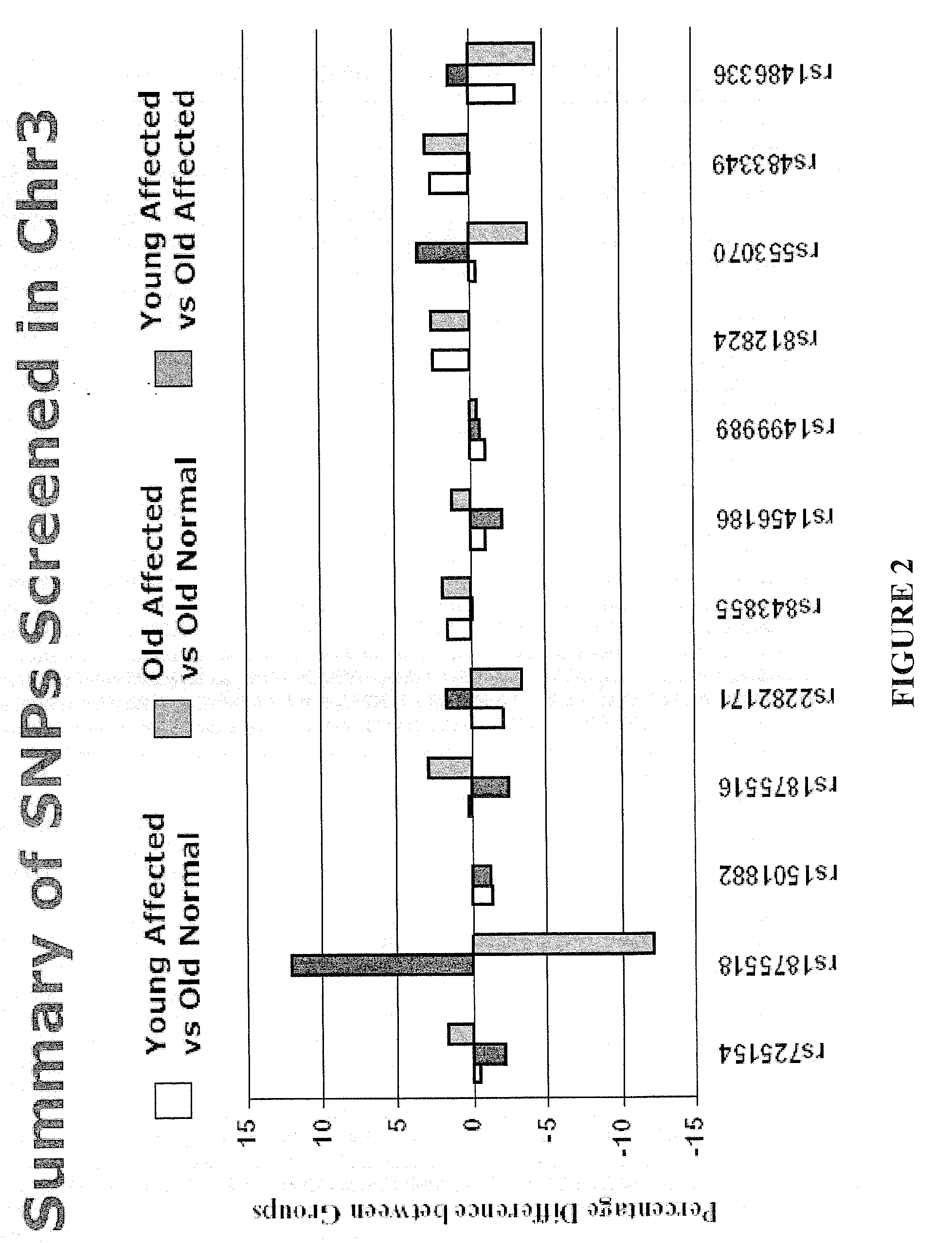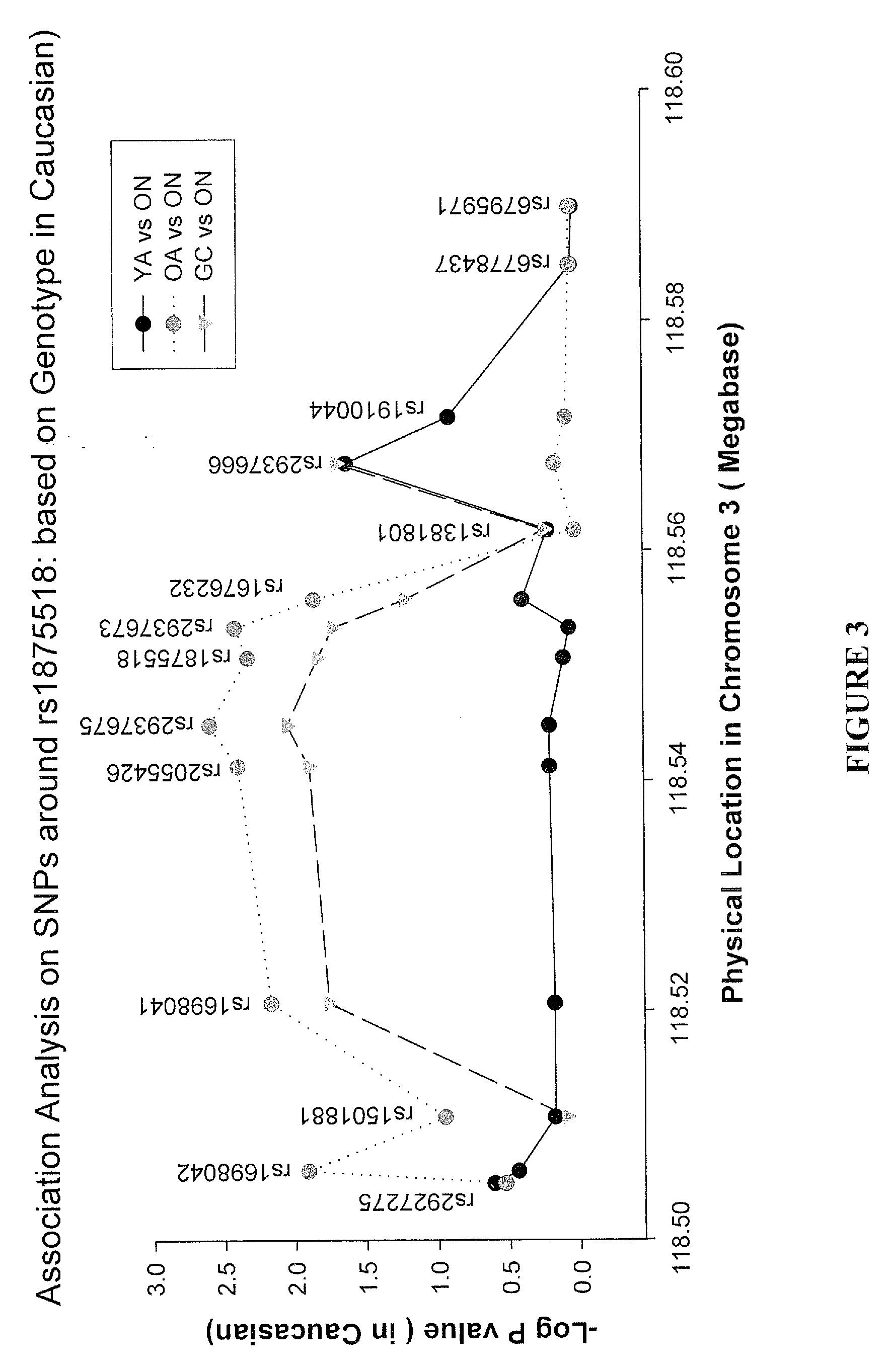Methods and compositions for correlating genetic markers with cardiovascular disease
- Summary
- Abstract
- Description
- Claims
- Application Information
AI Technical Summary
Benefits of technology
Problems solved by technology
Method used
Image
Examples
example 1
[0075]Overall summary: Using linkage analysis and association studies in families and isolated patients with cardiovascular disease (CAD), a 400 kb region in 3q13.31 was identified, containing a DNA region that affects susceptibility for CAD. A specific DNA haplotype was identified that is highly associated with CAD (p=0.0001) in Caucasians. This haplotype is defined by three markers: the single nucleotide polymorphism (SNP) marker rs1875518; a previously unidentified tetranucleotide GATA repeat, named 3M0238, and a third SNP, rs2937666. The actual alleles that are associated with susceptibility are shown in Tables 2 and 3. Both young onset and old onset CAD are affected by these haplotypes.
[0076]A genome wide screening in 420 families (GENECARD study Table 1) found the most significant linkage evidence (multipoint lod score=3.5) in chromosome 3q13 spanning over 120 megabases (Mb). This is shown in FIG. 1. Within this region is a genetic entity that influences the susceptibility for...
example 2
[0080]Coronary artery disease (CAD) is the leading cause of death in the United States and approximately 8% of CAD occurs in Americans under 50 years of age (AHA website). It is well established that CAD and death from CAD have a hereditary component (Marenberg, Zradkovic). The strong genetic predisposition of CAD may be partially explained by the heritability of disease related intermediate traits such as dyslipidemia. Dyslipidemia is a well-recognized risk factor for CAD, and abnormalities in serum lipids have been shown to have a genetic component (Breslow). Further, there is an increased incidence of familial lipoprotein abnormalities in family members of patients with premature CAD (Genest). Twin and adoption studies suggest that at least 50% of the observed variation in low-density lipoprotein (LDL) cholesterol is genetically determined (Austin, Rice) and segregation analysis has shown evidence for a major gene for high-density lipoprotein (HDL) cholesterol (Mahaney 1995). The...
example 3
[0101]Sequences of exemplary polymorphisms within the region of human chromosome 3q13.31 are depicted in Table 10. Of particular note are: the single nucleotide polymorphism as set forth by an adenine deletion in SEQ ID NO:15; the polymorphism as set forth by a 27 basepair duplication in SEQ ID NO:28; and the polymorphism as set forth by a CM insertion in SEQ ID NO:29. FIG. 6 depicts the genotypes of normal versus affected individuals with respect to these three variations.
[0102]FIG. 7 depicts differences in allele frequency between affected versus control (normal) cases with exemplary SNPs within the region of human chromosome 3q13.31.
[0103]FIG. 8 depicts the frequency of genetic markers within the region of human chromosome 3q13.31 correlated with affected and control (normal cases) and the significance of the correlation of the G allele of rs1875518 and the 253 allele of 3M0238 with CAD.
PUM
 Login to View More
Login to View More Abstract
Description
Claims
Application Information
 Login to View More
Login to View More - R&D
- Intellectual Property
- Life Sciences
- Materials
- Tech Scout
- Unparalleled Data Quality
- Higher Quality Content
- 60% Fewer Hallucinations
Browse by: Latest US Patents, China's latest patents, Technical Efficacy Thesaurus, Application Domain, Technology Topic, Popular Technical Reports.
© 2025 PatSnap. All rights reserved.Legal|Privacy policy|Modern Slavery Act Transparency Statement|Sitemap|About US| Contact US: help@patsnap.com



